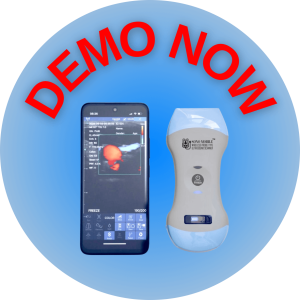Mobile ultrasound technology is highly valuable in nephrology for diagnosing, monitoring, and managing a wide range of kidney-related conditions. Here’s how it can be beneficial:
- Assessment of Kidney Size and Structure: Mobile ultrasound can accurately measure kidney size and assess structural abnormalities, such as cysts, tumors, or congenital anomalies, aiding in the diagnosis of various kidney diseases.
- Evaluation of Hydronephrosis: It helps in identifying and grading hydronephrosis, determining the severity of kidney obstruction, and guiding further management to alleviate the obstruction and prevent kidney damage.
- Detection of Kidney Stones: Ultrasound can quickly identify the presence, size, and location of kidney stones, allowing for timely treatment decisions and monitoring of stone passage or treatment effectiveness.
- Guidance for Biopsies: Ultrasound-guided kidney biopsies improve the accuracy of needle placement, reduce complications, and increase the diagnostic yield, which is crucial for diagnosing glomerular diseases and other kidney pathologies.
- Monitoring Chronic Kidney Disease (CKD): Regular ultrasound exams can track changes in kidney size, cortical thickness, and the presence of cysts or scarring, providing valuable information for managing CKD progression.
- Evaluation of Renal Blood Flow: Doppler ultrasound can assess renal blood flow and detect abnormalities such as renal artery stenosis, which is important for diagnosing and managing conditions like hypertension and ischemic nephropathy.
- Assessment of Kidney Transplants: Mobile ultrasound is essential for monitoring kidney transplant patients, evaluating graft function, and detecting complications such as rejection, fluid collections, or vascular issues.
- Detection of Urinary Tract Obstructions: It helps in identifying obstructions in the urinary tract, including ureteral obstructions and bladder outlet obstructions, guiding appropriate interventions to restore normal urine flow.
- Fluid Management: Ultrasound can evaluate fluid status in patients with kidney disease, helping to manage fluid overload or dehydration by assessing parameters like inferior vena cava diameter and bladder volume.
- Diagnosis of Polycystic Kidney Disease (PKD): Ultrasound is a primary tool for diagnosing and monitoring PKD, identifying the number, size, and distribution of kidney cysts, and assessing the progression of the disease.
- Evaluation of Acute Kidney Injury (AKI): Mobile ultrasound can help determine the cause of AKI by assessing kidney size, echogenicity, and the presence of obstructions or other abnormalities, guiding appropriate treatment.
- Bedside and Remote Assessments: The portability of mobile ultrasound allows nephrologists to perform bedside assessments in hospitalized patients or conduct evaluations in outpatient or remote settings, enhancing accessibility to care.
- Patient Education and Engagement: Ultrasound images can be used to educate patients about their kidney condition, treatment options, and the importance of follow-up care, improving patient understanding and compliance.
Overall, mobile ultrasound enhances nephrology by providing detailed, real-time imaging that improves diagnostic accuracy, guides interventions, monitors treatment progress, and engages patients in their care, ultimately leading to better outcomes for kidney patients.



